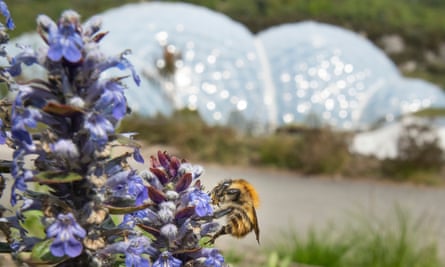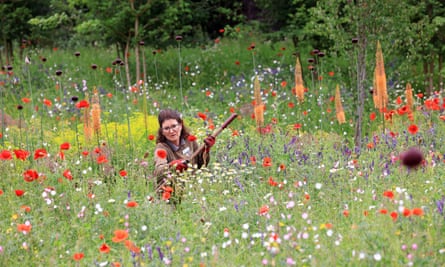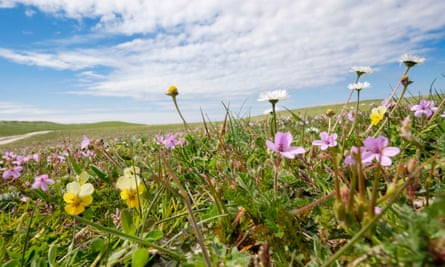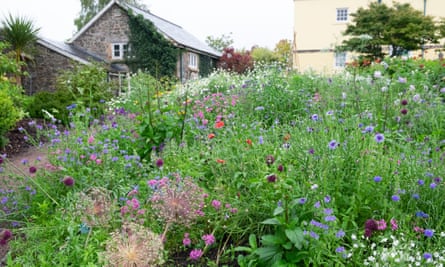Deep Dale, Peak District, Derbyshire
One of 23 nature reserves across the UK owned by conservation charity Plantlife that sparkle with wildflowers each summer (use the website’s map to find your nearest), this upland grassland in the Peak District near Buxton, is perennially popular among botanists. The range of species you might spot here includes drifts of yellow mountain pansies, early purple orchids, pink musk-mallow and lilac-tinted heath speedwell. Plantlife is also known for campaigns such as No Mow May and National Meadows Day (2 July), when it organises wildlife ID courses, scything competitions and art activities at many of its sites.
Free access (a free walking guide can be downloaded from the website) but note that a local farmer grazes cattle on the reserve from July to November, plantlife.org.uk
Superbloom, Tower of London

From second world war allotments to an ice rink to a poppy field: the Tower of London moat has seen more reinventions than the wallpaper at No 11, a tradition set to continue in 2022 with its new Superbloom display. More than 20 million pollinator-friendly flower seeds have been sown, heralding a flood of blooming cornflowers, poppies, common toadflax and more when the event opens on 1 June. At this floral celebration of the Queen’s Platinum Jubilee visitors can walk in, or whiz down to it on a sleek four-lane slide (upcycled from a 2013 installation at Cliveden). When the event ends in September, the bee- and bird-friendly landscape will remain in place.
£12 adults/£6 children, superbloom.hrp.org.uk
Pollinator Pathmaker, Eden Project, Cornwall

“If pollinators designed gardens, what would humans see?” That’s the concept behind the Pollinator Pathmaker, Alexandra Daisy Ginsberg’s new garden at the Eden Project. A living artwork, the garden has been designed with insects’ (rather than gardeners’) tastes in mind, using a custom algorithm and a specially curated palette of plants. In full bloom for the first time this month, the 55 metre-long garden is part of the Eden Project’s “Create a Buzz” programme, exploring the role, plight and restoration of native UK pollinators.
£32.50 adults/£11 children (tickets are also annual passes), edenproject.com
Central Mosque, Cambridge

A city-centre mosque may seem an unlikely place to find a pollinator-friendly oasis but at this recently built “eco” mosque, both the Islamic garden at its entrance and a neighbouring community garden are pioneeringly sustainable. A collaboration between garden designer Emma Clark and ecological landscape designers Urquhart & Hunt (whose beaver-friendly Rewilding Britain garden is a highlight of this year’s wild-themed Chelsea Flower Show), the Islamic-style garden encompasses elements of both the Paradise Gardens described in the Qur’an and naturalistic, biodiversity-focused English planting.
Entrance is free but donations are welcome, cambridgecentralmosque.org
RHS Wildlife Garden, Surrey

Part of the new RHS Hilltop centre, the £35m “Home of Gardening Science” at Wisley, this one-acre wildlife garden is all about bee- and bug-friendly plants. Designed by Ann-Marie Powell it bridges the gap between gardens and nature reserves, with all the plants having been chosen from the RHS Plants for Pollinators list. Two large pools provide significant space for aquatic and marginal species – among them purple iris and the jauntily named pickerel weed – while a mini-model garden shows how to create a wildlife-friendly garden at home.
£15.95 adults/£7.95 children (free for RHS members), rhs.org.uk
Uist, Outer Hebrides

Between June and August each year, rare machair habitats (low-lying exposed coastlines of sand and shells) in north-west Scotland and the west coast of Ireland are flecked with the likes of sea rocket, sea bindweed and rare Hebridean marsh orchids. At their most extensive in the Outer Hebrides, where traditional crofting practices help the machair to thrive, one of the best areas to see it is the island of North Uist. Here, at the RSPB’s Balranald nature reserve, weekly 90-minute guided walks run from now until the end of July, taking in the machair’s rainbow-hued highlights as well as birds such as corncrakes and skylarks.
Guided walks every Tuesday to 9 August, £6 adults (£3 members)/children free, general entrance free, rspb.org.uk
Hogchester Meadows, Dorset

Helping private garden owners host open days for charity, the National Garden Scheme is as intrinsic a part of British summertime as brollies at a barbecue. If you associate it only with striped lawns and frothy herbaceous borders, however, this summer’s openings may surprise you. A growing focus on gardening for wellbeing, and biodiversity, has led to the introduction of several wilder gardens in 2022. Among them is Hogchester Farm, a 75-acre former dairy farm outside Charmouth whose work with the Dorset Wildlife Trust has seen much of the land given back to nature. Its hay meadows – rich with orchids, foxgloves and primroses – are hosting interactive NGS open days on 25 June and 16 July, and are open for a stroll every day in May, June and July.
NSG open days 25 Jun, 16 July, general admission to meadows daily in May, June and July; NSG days £4 adults/£1 children, general admission free; ngs.org.uk
Saving pollinators, National Botanic Garden of Wales, Carmarthenshire

Where better to make a beeline for on National Meadows Day (2 July) than a restored hay meadow? That’s the conclusion at the National Botanic Garden of Wales, anyway. Just east of Carmarthen, the attraction is home to the National Seed Bank of Wales and is at the forefront of a drive to harvest wildflower seed and restore the nation’s meadows. Visit the garden on 2 July and you can join one of two short walks – at 11am and 1.30pm – that will navigate a blossoming pathway through an orchid-rich, restored hay meadow. On the way, you’ll discover how restoring wildflower-rich meadows can be as effective in combating climate change as planting trees (hint: it’s all to do with the absorption of atmospheric carbon).
Entrance £13.75 per adult/£6.75 per child, booking for walks not essential, botanicgarden.wales
Muker Meadows, Yorkshire Dales

Summer in the Yorkshire Dales distilled in one spot, the four fields that make up Muker Meadow – part of Prince Charles’s Coronation Meadows regeneration initiative – are among the most archetypal upland hay meadows in the Yorkshire Dales. Sympathetic management supports the blossoming of swathes of flowers and grasses at their June peak, from melancholy thistle to sweet vernal grass. A flagged footpath leads visitors through this Swaledale spectacle in full technicolour detail but don’t stop there; together with eight other local meadows these ones make up a protected site of special scientific interest (also called Muker Meadows) and much of it can be viewed via public footpath.
Free access, coronationmeadows.org.uk
Lacock Abbey, Wiltshire

As the one-time home of pioneering photographer William Henry Fox Talbot, it’s fitting that Lacock Abbey, a National Trust site south of Chippenham, should have established a new wildflower meadow. Not only because of Fox Talbot’s photographic connections but because he was a keen botanist (he’s credited with leading the campaign to preserve Kew Gardens as a national botanic garden when it was under threat in the 1830s). Reclaimed from farmland last year and set to bloom for the first time this June, the meadow has paths mown through it for those who want to explore its grasses and flowers close up (and views of the abbey framed by wildflowers).
Entrance £15 per adult/£7.50 child, free for members, nationaltrust.org.uk
